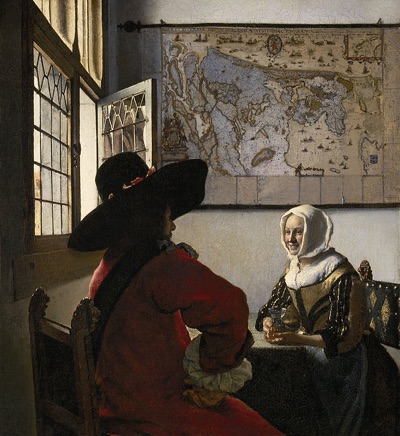Officer and Laughing Girl


The main subject is the woman, and soft, direct light falls on her face. She resembles Vermeer's wife, Catharina Bolnes, who is believed to have posed for many of his paintings. With x-ray photographs, art historians can see that Vermeer had planned to paint the woman with a large white collar which would have hid much of her yellow dress.[2] Also, her cap was later extended to cover all of her hair, in order to draw attention to her face and expression. This yellow bodice with braiding has appeared in many of Vermeer's other portraits. It is called a schort and was usually worn as an everyday, common dress. The woman is also wearing a blue apron over her dress, but it is hidden in the shadows caused by the table. Blue aprons were common attire at that time because they hid stains well. Art historians have interpreted this to mean that the soldier surprised the girl with an impromptu visit during her morning chores. The woman is holding a wine glass, usually used for white wine. Because at that time, wine cost more than beer, it illustrates her wealth.
The man in the painting is a cavalier wearing a red coat and an expensive hat, showing his wealth and rank. His hat is wide- brimmed and made of beaver pelt, which was weather resistant and good for snowy and rainy conditions. The pelts for these hats were imported from the New World. This hat was probably from New Netherlands, which was then under the Dutch West India Company's control. The red in his uniform is associated with power and passion, bringing a passionate and emotional mood to the painting. His rank as an officer is identified by the black sash he wears. However, his presence in the immediate foreground is what the viewers notice first. His striking presence adds drama and mystery to the mood of the composition. This artistic device—in which an object is placed in the foreground to increase the depth of field of the overall painting—is called repoussoir. Caravaggio often used this technique and Vermeer probably learned it from a Caravaggist's painting.
The meaning of the interaction between the woman and the soldier is unknown. Many art historians believe that it only portrays a woman being innocently and honorably courted by this soldier. However, some have argued that her open hand and smile could be asking for payment before coitus.
"The Dutch painter Johannes Vermeer of Delft (1632-1675) holds a position of great honor among map historians. Several of his painting illustrate maps hanging on walls or globes standing on tables or cabinets. Vermeer painted these cartographical documents with such detail that it is often possible to identify the actual maps. Evidently, Vermeer was particularly attached to a Willem Blaeu - Balthasar Florisz van Berckenrode map of Holland and West Friesland, as he represented it as a wall decoration in three of his paintings... Though no longer extent, the map's existence is known from archival sources and second edition published by Willem Blaeu in 1621, titled "Nova et Accurata Totius Hollandiae Westfriesiaeq. Topographia, Descriptore Balthazaro Florentio a Berkenrode Batavo". Vermeer must have had a copy at his disposal (or the earlier one published by Van Berckenrode). Around 1658 he showed it as a wall decoration in his painting "Officer and Laughing Girl", which depicts a soldier in a large hat sitting with his back to viewer, talking with a smiling girl who holds a glass in her hand. Bright sunlight bathes the girl and the large map on the wall. Vermeer's gift for realism is evidenced by the fact that the wall map, mounted on linen and wooden rods, is identifiable as Blaeu's 1621 map of Holland and West Friesland. He captures all of its characteristic design, decoration, and geographic content."
Artist:
Johannes Vermeer
Year:
1657
Type:
Oil of Canvas
Dimensions:
19.87 in × 18.13 in
Location:
The Frick Collection
New York City, USA
EARLIER PAINTING
NEXT PAINTING
Other Artists
About this Painting


